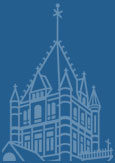
- Vested Interest
Playing With Symbols
Symbol is reality at its most intense degree of being expressed. One resorts to symbol when reality swamps all other forms of discourse.
-Aiden Kavanagh, “Elements of Rite”
A couple of weeks ago, I started a session with young acolytes this way: I wrote the word "WORD" on the board, and underneath it, that same word in the languages I could think of offhand (Hebrew and Greek). I put a plastic cup of water on the table. And I passed out sheets of origami paper.
Together, then, we brainstormed translations for "word" into all the languages we could think of (Spanish, French, Mandarin, Latin, Pig Latin, etc.). We talked about the water, and then I drank it, and we talked about it some more. We folded the paper, with much hilarity, into paper cranes.
Can you guess what we were doing? Do you see what these three elements—word, water, crane—have in common?
For many of us, our introduction to symbolism takes place somewhere in English/Language Arts class, where we learn to assign a rather clunky one-to-one correspondence: in The Great Gatsby, the eyes of T.J. Eckleburg symbolize God. Many of us stop there in our understanding, and wonder why authors would play such a silly game.
But talking about symbols, and playing with them, are things we all do all the time. A toddler turns her first blanket into a symbol of parental warmth and security that allows her to explore the world outside of her parents' arms. For members of my generation, growing and tending an elaborate mustache has become a key marker of the hipster, signifying a certain kind of consciously self-deprecating pedantry (at least, that’s my take on it). And think about the credit card many of us carry with us every day: a marker for the promise and the disappointment of the American economic system. Symbols are rich with meanings, expressing many things at the same time. As the great liturgical theologian Aiden Kavanagh writes above, they work to communicate realities which are too complex, rich, and intense for a single meaning.
When we perform liturgy, in the pews or in the pulpit, we play with symbols in a way that's more intentional and deliberate than most of us are used to on a daily basis. Every week, for example, we hear the words of Jesus over the bread, "This is my body;" and we are given the space to wonder, well now, what exactly did he mean by that? Most Christians believe that the answer to this question is important. I would argue that the process of answering it is even more so. Consciously playing with the symbols in our worship is one way we open ourselves to the transforming work of the Holy Spirit within us.
To return to the word, the water, and the paper cranes: we hypothesized that "word" was different from "logos" but perhaps also somehow the same; that the cranes were somehow real and not-real birds at the same time; that water was life and death, and was still with us in the room even when I'd drunk it all. We joked and laughed and paid attention to these small everyday things, and to how they functioned in us and between us. In other words, we played, but with a little more attentiveness and reflectiveness than we often tend to. Next time you're in church, try paying attention to the symbols you notice and how they might function. Where is the reality that is expressed most intensely through them?
At "Vested Interest," church nerd Mary Davenport Davis explores all things liturgy and music at Trinity and beyond. Chime in with comments and questions!


Comments